New Species Of Winged Reptile Found On Isle of Skye – Its Diversity Was Greater Than Previously Assumed
Eddie Gonzales Jr. - AncientPages.com - A remarkable discovery was made on Skye, Scotland's second-largest island.
Researchers unearthed the skeleton of a new pterosaur species, a flying dinosaur that could have soared the skies 168 million years ago during the Middle Jurassic period.
Reconstruction of Ceoptera evansae. Image credit: © NHM & Witton 2021
The unveiling of the new pterosaur, a member of the Darwinoptera clade, is a stunning discovery
discovery that illuminates the diversity that once existed on pur planet within this group.
It is far beyond what we had previously imagined, according to researchers from the Natural
History Museum, University of Bristol, University of Leicester, and University of Liverpool.
These magnificent creatures were present on Earth for over 25 million years, from the late Early
Jurassic to the latest Jurassic era, spreading their wings across every corner of our globe.
This discovery paves the way for a more intricate and fascinating understanding of early pterosaur
evolution. At the same time, it is another piece of evidence of nature's boundless creativity
and adaptability.
The recent finding supports a more complex model for the initial evolution of pterosaurs.
The scarcity and partial nature of Middle Jurassic pterosaur fossils have historically
prevented efforts to comprehend early pterosaur evolution.
Life restoration of Dearc sgiathanach, a pterosaur from Jurassic Scotland. Image credit: El fosilmaníaco - CC BY-SA 4.0 DEED
However, this new discovery reveals that all main Jurassic pterosaur groups developed
much earlier than previously understood, specifically before the conclusion of the Early
Jurassic period.
Additionally, it indicates that pterosaurs continued to exist into the latest Jurassic period, co-existing with avialans - dinosaurs that eventually evolved into today's birds. The remains of the flying dinosaur include a partial skeleton of a single entity, encompassing sections of the shoulders, legs, wings, and spine. These bones are still fully encased in rock and can only be examined through the use of CT-scanning technology.
“Ceoptera helps to narrow down the timing of several major events in the evolution of flying reptiles.
Its appearance in the Middle Jurassic of the UK was a complete surprise, as most of its close relatives are from China. It shows that the advanced group of flying reptiles to which it belongs appeared earlier than we thought and quickly gained an almost worldwide distribution,” said Professor Paul Barrett, Merit Researcher at the Natural History Museum and senior author on the paper.
Reconstruction of Ceoptera evansae. Image credit: © NHM & Witton 2021
Lead author Dr Liz Martin-Silverstone, a palaeobiologist from the University of Bristol, said: "The time period that Ceoptera is from is one of the most important periods of pterosaur evolution, and is also one in which we have some of the fewest specimens, indicating its significance. To find that there were more bones embedded within the rock, some of which were integral in identifying what kind of pterosaur Ceoptera is, made this an even better find than initially thought. It brings us one step closer to understanding where and when the more advanced pterosaurs evolved."
Pterosaurs are the earliest vertebrates capable of active flight and are recognized as the largest flying creatures ever discovered.
They ruled in the skies for an amazingly long period of 150 million years before their extinction, spreading across all continents and evolving into an array of forms and sizes.
To date, about 60 genera and 120 species of pterosaurs have been identified, with sizes varying from that of a small sparrow to those boasting wingspans exceeding 12 meters.
Written by Eddie Gonzales Jr. - AncientPages.com - MessageToEagle.com Staff Writer
More From Ancient Pages
-
 Direct Link Between Dinosaur Fossils And The Griffin Legend – Challenged
Fossils | Jun 26, 2024
Direct Link Between Dinosaur Fossils And The Griffin Legend – Challenged
Fossils | Jun 26, 2024 -
 Meteorite That Killed Dinosaurs Responsible For Turning Tomatoes Red – Scientists Say
Paleontology | Aug 9, 2016
Meteorite That Killed Dinosaurs Responsible For Turning Tomatoes Red – Scientists Say
Paleontology | Aug 9, 2016 -
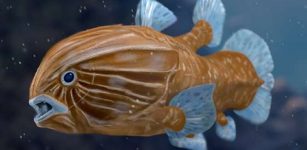 Fossil Study: Coelacanths Thrived In Switzerland After A Mass Extinction
Fossils | Jul 28, 2023
Fossil Study: Coelacanths Thrived In Switzerland After A Mass Extinction
Fossils | Jul 28, 2023 -
 Unique Three-Eyed Fossil Animal From 520-Million-Year-Old Rocks Reveals Details Of Early Animal Evolution
Evolution | Sep 5, 2023
Unique Three-Eyed Fossil Animal From 520-Million-Year-Old Rocks Reveals Details Of Early Animal Evolution
Evolution | Sep 5, 2023 -
 500-Million-Year-Old Sea Worm Named After ‘Dune’ Monster Was Unknown To Science Until Now
Paleontology | Aug 3, 2023
500-Million-Year-Old Sea Worm Named After ‘Dune’ Monster Was Unknown To Science Until Now
Paleontology | Aug 3, 2023 -
 Computers Will Decide What Wiped Out The Dinosaurs
Paleontology | Oct 4, 2023
Computers Will Decide What Wiped Out The Dinosaurs
Paleontology | Oct 4, 2023 -
 170-Million-Year-Old Sea Monster Identified As The Oldest Mega-Predatory Pliosaur
Evolution | Oct 23, 2023
170-Million-Year-Old Sea Monster Identified As The Oldest Mega-Predatory Pliosaur
Evolution | Oct 23, 2023 -
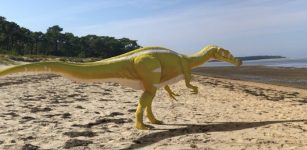 New Spinosaurid Dinosaur Found In Spain
Paleontology | Jun 7, 2023
New Spinosaurid Dinosaur Found In Spain
Paleontology | Jun 7, 2023 -
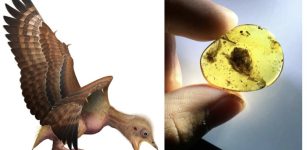 Why Ancestors Of Modern Birds Survived When All The Dinosaurs Died
Evolution | Jul 11, 2023
Why Ancestors Of Modern Birds Survived When All The Dinosaurs Died
Evolution | Jul 11, 2023 -
 Perfectly Preserved Turtle Fossil Gives Clues To Habitat 150 Million Years Ago
Paleontology | Jul 27, 2023
Perfectly Preserved Turtle Fossil Gives Clues To Habitat 150 Million Years Ago
Paleontology | Jul 27, 2023 -
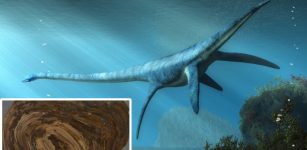 150-Million-Year-Old Stomach Stone Found In The UK The Oldest Discovered Fossil Of Its Kind
Fossils | Jul 11, 2023
150-Million-Year-Old Stomach Stone Found In The UK The Oldest Discovered Fossil Of Its Kind
Fossils | Jul 11, 2023 -
 Jurassic Sea Creature Unearthed In A Quarry Near Peterborough, UK
News | Dec 14, 2023
Jurassic Sea Creature Unearthed In A Quarry Near Peterborough, UK
News | Dec 14, 2023 -
 Earth’s First Animals Had Particular Taste In Real Estate
Evolution | May 10, 2023
Earth’s First Animals Had Particular Taste In Real Estate
Evolution | May 10, 2023 -
 Hollow Bones That Let Dinosaurs Become Giants Evolved At Least Three Times Independently
News | Apr 11, 2023
Hollow Bones That Let Dinosaurs Become Giants Evolved At Least Three Times Independently
News | Apr 11, 2023 -
 Rare Find Of An Unusual Prehistoric ‘Giant Goose’ In Australia
Paleontology | Jun 8, 2024
Rare Find Of An Unusual Prehistoric ‘Giant Goose’ In Australia
Paleontology | Jun 8, 2024 -
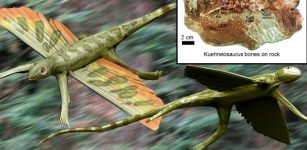 200-Million-Year-Old Flying Reptile Kuehneosaurus Discovered In Somerset, UK
Paleontology | Jan 26, 2024
200-Million-Year-Old Flying Reptile Kuehneosaurus Discovered In Somerset, UK
Paleontology | Jan 26, 2024 -
 Swimming Secrets Of Prehistoric Reptiles Unlocked – New Study
Paleontology | Apr 23, 2023
Swimming Secrets Of Prehistoric Reptiles Unlocked – New Study
Paleontology | Apr 23, 2023 -
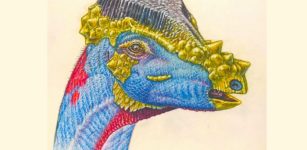 Newly Described Species Of Dome-Headed Dinosaur May Have Sported Bristly Headgear
News | May 24, 2023
Newly Described Species Of Dome-Headed Dinosaur May Have Sported Bristly Headgear
News | May 24, 2023 -
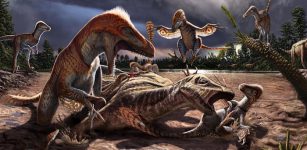 Evidence Utahraptor, World’s Largest Raptor Lived Millions Of Years Earlier Than Previously Thought
Paleontology | May 4, 2023
Evidence Utahraptor, World’s Largest Raptor Lived Millions Of Years Earlier Than Previously Thought
Paleontology | May 4, 2023 -
 Long-Necked Reptiles Were Decapitated By Their Predators, Fossil Evidence Confirms
Paleontology | Jun 24, 2023
Long-Necked Reptiles Were Decapitated By Their Predators, Fossil Evidence Confirms
Paleontology | Jun 24, 2023



